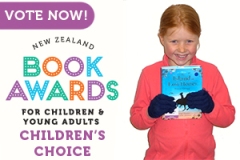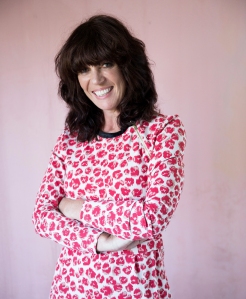 Stacy Gregg has been voted for by kids all over New Zealand to become a
Stacy Gregg has been voted for by kids all over New Zealand to become a
finalist in the Children’s Choice Junior Fiction category, for the second in her series of horse books inspired by true stories. She is also in the judge’s list for this year’s Junior Fiction award. Her 2013 book, The Princess and the Foal, was a finalist in the Junior Fiction category of the 2014 New Zealand Post Book Awards for Children and Young Adults.
We asked Stacy a few questions about where this story came from, and how she went about researching it.
1. What was the genesis for this, your second story inspired by a true horsey tale?
It began when I fell in love. I was looking through a book of rare horse breeds and I turned the page and there was this incredible creature with startling blue eyes, this face as white as bone china, strange markings like a dark bonnet over its ears, and a mane so tangled with sea grasses that it looked like it had dreadlocks. That was my first experience of seeing an Abaco Barb. I’d never even heard of them before, but I was struck by this image and so I began to research the horse and discovered that its story was remarkable.

The breed has lived in total isolation on a desert island in the Caribbean for 500 years and its DNA can be traced directly to the ancient bloodlines of horses in Spain. The bloodlines prove the Abaco Barbs came over from Spain with Christopher Columbus – but how did they end up running wild on this island in the middle of the Bahamas? I started to put the puzzle together and produced a dual narrative told through the eyes of two young girls, one in the present day in the Bahamas and the other in Spain in 1493. Beatriz and Felipa are both in love with their horses and will ultimately risk their lives to save them.
2. What were the main resources you used to do your research? Which of these shaped the book the most?
 As an ex-journalist I am very vigorous when it comes to the research for my books. The starting point is usually location: I had already travelled to Spain for a previous novel so I had my key locations there like the Alhambra clearly in my mind and my editor, Lizzie Clifford, who has worked with me now on 16 books, grew up in the Bahamas.
As an ex-journalist I am very vigorous when it comes to the research for my books. The starting point is usually location: I had already travelled to Spain for a previous novel so I had my key locations there like the Alhambra clearly in my mind and my editor, Lizzie Clifford, who has worked with me now on 16 books, grew up in the Bahamas.
Back home, I built up a library of excellent detailed historical reference books on Queen Isabella and Columbus and Spain in 1493, but some details required more certainty than the books could provide. I have one particular scene where a key character dies from the Black Death. To be absolutely certain I had my facts right I had to track down the world’s pre-eminent authority on Bubonic Plague, Dr Joseph Byrne at Belmont University in the United States. He was an amazing resource – I am now a plague expert thanks to him. I also know how to navigate a carracas from Spain to the Caribbean and can speak fluent Bahamian patois! I could also bore you to tears about the intricacies of the life cycles of sea thimble jellyfish (one of the characters is a marine biologist).
3. How did you tailor this book to the age-group it reaches?
I am always surprised when I get the printed book back and realise that I have in fact written a kids book because the process to me feels frightfully adult. There’s such a depth of history and fact in my stories. I want young readers to come away from a novel feeling like they have all this newfound knowledge absorbed almost by osmosis – the byproduct of a swashbuckling good yarn. There’s no reason why you can’t learn and have fun at the same time!
4. Can you recommend any books for children/young adults who love this book (and your other books!?)
I’ve been having vigorous debates about this with friends lately about what middle graders should be reading. I feel very strongly about the need for children’s literature to provide strong, positive role models that young readers can aspire to be. I love the fact that the girls in my books are powerful and heroic and solve their own problems. I think reading  about characters who face their fears and achieve their goals can be inspiring for young readers. I get quite a bit of tear-jerking mail from my readers telling me that my books have inspired them to ride horses and pursue their pony dreams.
about characters who face their fears and achieve their goals can be inspiring for young readers. I get quite a bit of tear-jerking mail from my readers telling me that my books have inspired them to ride horses and pursue their pony dreams.
When you are reading, I think you should want desperately to be the character. I wanted so bad to be Scout in To Kill a Mockingbird. Or Alec Ramsay in The Black Stallion. I definitely wanted to be Hazel in Watership Down. Rabbits can be heroes too.
6. What is your favourite thing to do when you aren’t reading or writing, and why?
Horses – always, always horses.
_____
If you want to know more about Stacy, check out her website here.
For reviews of her book, check out Bob Docherty’s review here.
This is day 14 of the blog tour featuring each of the finalists in the Children’s Choice category of the awards. Yesterday’s feature was Canterbury Quake, by Desna Wallace, on My Best Friends are Books. Tomorrow’s feature will be How I Alienated My Grandma, by Suzanne Main, which will be covered on Booknotes Unbound.
What you might have missed from the Junior Fiction list:
Dragon Knight: Fire!, by Kyle Mewburn & Donovan Bixley
1914 – Riding into War, by Susan Brocker
My Story: Canterbury Quake, by Desna Wallace
